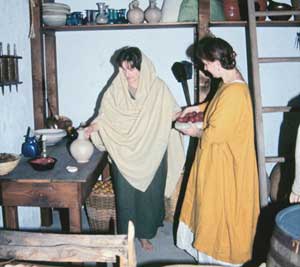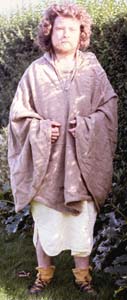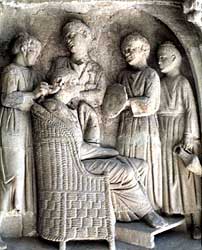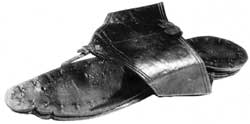
Click on the image for a larger version. |
Image
details:
Female dress of the north-western provinces
Image ownership:
© Cohors Quinta Gallorum, courtesy
of Alex Croom |

Click on the image for a larger version. |
Image
details:
Man wearing 'Gallic coat'
Image ownership:
© Cohors Quinta Gallorum, courtesy
of Alex Croom |
The Vindolanda tablets are a rich source of evidence for Latin
terms for clothing and footwear (for example 184,
185,
186),
although it can difficult to identify the precise meaning of terms,
especially those that refer to capes or cloak, or to relate individual
terms to the types of clothing known from artistic representations
and archaeology. Excavations at Vindolanda have also yielded the
largest group of textiles (almost all wool) of any site in the western
Roman empire. Most fragments are too small to identify the garment
from which they come, although they do yield much information on
textile production. Clothes were made at Vindolanda (192
refers to the supply of 38 pounds of wool) but clothing also formed
a large proportion of supplies. A small number of more complete
items survive, including a child's
sock. Our most important source for reconstructing dress in
the north-west Roman provinces is funerary sculpture, some from
Britain but especially from northern Gaul. Out of uniform, clothing
worn at Vindolanda would have resembled that worn across the northern
provinces. The basic garment was the 'Gallic coat', a wide unfitted
tunic, normally with sleeves that were woven with the garment or
sewn to it. This was a 'unisex' garment but worn to different lengths,
knee-length for men, calf- or ankle-length for women. Tunics were
also common and are frequently mentioned in the tablets, including
a special type for dining (196).

Click on the image for a larger version.
|
Image
details:
Toilette scene from a funerary monument found
at Neumagen, near Trier, Germany. A lady views her reflection
in the mirror while 4 servants arrange her hair and bring
water
Image ownership:
Vroma. Photo Barbara McManus
Trier, Landesmuseum
|
Over the tunic or coat was worn a cloak: perhaps the commonest
term for the military cloak was the sagum, both the term
and style borrowed from Gaul. The paenula was perhaps a hooded
cloak. Some of these items were grouped under the term synthesis,
suggesting a costume made up of separate pieces of apparel (196).
Critical to the maintenance of morale on the northern frontier was
an adequate supply of underwear: loincloths (subligaria)
were probably worn as a male undergarment (346)
and subuclae or subunculae were perhaps 'vests' (196).
A small number of tablets mention items of jewellery, including
rings (anuli) (196)
and dress accessories and personal ornaments were recovered in excavation.
Some of the brooch types found at Vindolanda and other fron tier
forts reflect local tastes and are among the few pieces of archaeological
evidence from Roman forts for contact with the native
population.

Click on the image for a larger version.
|
Image
details:
The sole and strap of a woman's sandal, stamped
with the initials of the maker (Lucius Aebutius Thales) and
other designs, including a vine leaf.
Image ownership:
© Vindolanda Trust |

Click on the image for a larger version.
|
Image
details:
Some examples of more elaborate footwear
from Vindolanda, with the leather of the uppers cut away to
produce a type of 'fishnet' effect. Despite their flimsy appearance,
such boots were hard wearing. They were worn by men and women.
Image ownership:
© Vindolanda Trust |
Terms for footwear are also numerous, especially among the tablets
excavated in the 1990s. It is again difficult to relate individual
terms to the different archaeologically recorded types. A massive
number of leather shoes and boots of men, women and children have
survived at Vindolanda. The caliga, the traditional Roman
military boot, formed of an open sandal-like upper and a nailed-sole,
was scarcely represented at Vindolanda (the nickname given to the
emperor Caligula, 'little boot' by the soldiers, is the diminutive
form of this term). Some shoes were made of one piece (the carbatina)
but in most instances the upper and sole were made of separate pieces
of leather. Uppers could be closed in a variety of different ways,
with panels often cut out to form openwork designs. Wooden clogs,
perhaps for the heat of the bathhouse floor, and a fine slipper
with a maker's stamp were also found. However the high degree of
wear, plus frequent repairs and patches, show that the supply of
leather was not as plentiful at Vindolanda as it was at other forts.
Tablet database link: Browse all tablets that mention clothing.
|